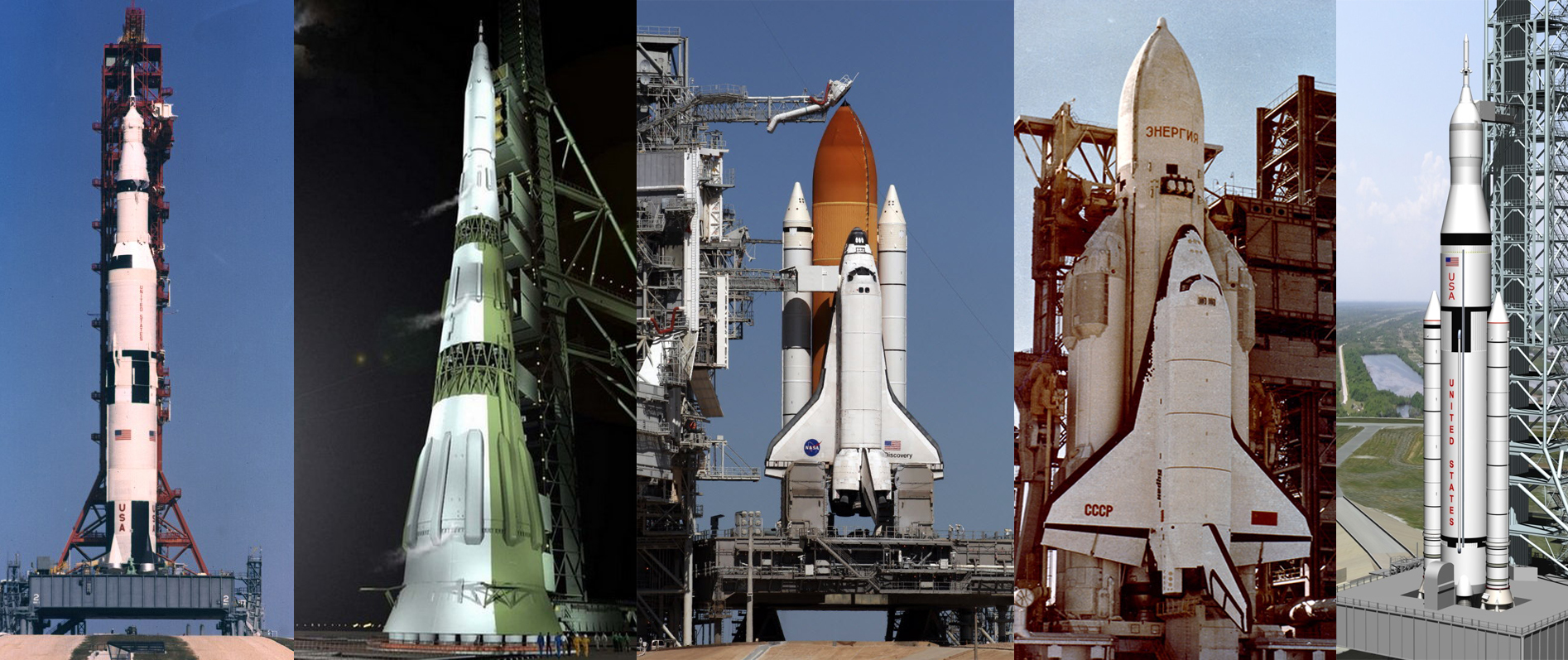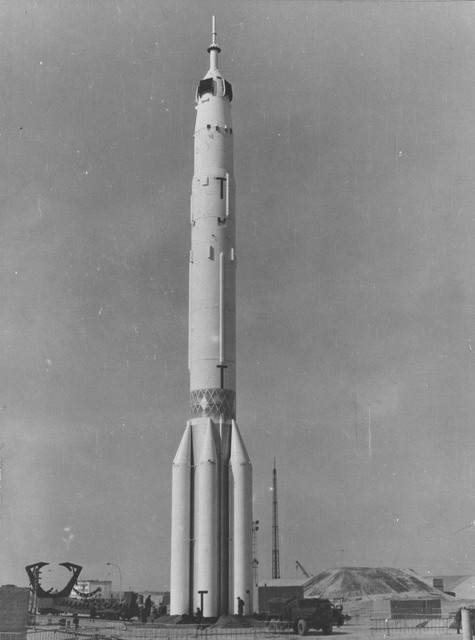Chronicle of space super heavyweight. Part 1. Moon "dinosaurs"

Man since ancient times sought to surpass himself. Using the potential laid down by nature, we were simultaneously afraid and drawn to everything grand. If our ancient ancestors sought to become like gods, erecting colossal monuments of architecture, then without a doubt the space age has become the “tower of Babel” of our time. Best of all, the truly cosmic ambitions of the human genius express his large-scale technological projects. Below we will discuss the history of the creation of super-heavy space transportation systems and the future prospects for their use.
In March, 59, two years before the first manned space flight, NASA conducted firing tests of the most powerful at that time (and before the early 80s) F 1 rocket engine, the brainchild of Rocketdyne.
This single-chamber LRE weighing 9 tons, a weight of 700 tons and a specific impulse of 265s, was assigned an important role in the future lunar rocket of the Apollo program. From the projects of the moon rocket Saturn C 2, 3 and 4, in the final version of the carrier designed by the team of Werner von Braun, by 62g a configuration was already chosen with 5 F 1 engines - Saturn C 5 or later Saturn 5.
')
Reference: The specific impulse of the rocket engine expresses its effectiveness. Being the ratio of the created amount of movement (impulse) to fuel consumption, it is translated into “human” language as time (in seconds), during which the engine generates 1kg thrust, spending fuel of the same mass. The higher the U. impulse, the more efficient the engine and more economical fuel consumption. In the post, this value, as well as thrust, is indicated for sea level at launch and increases on average during the flight by 10-15%.
One of the fire tests of the engine F 1 in 60g. Pay attention to the characteristic dark rocket jet. Features of the engine nozzle cooling system, when a portion of the fuel is pumped into the combustion chamber through the tubes in its structure.

Installation of engines F 1 on the first stage of the PH Saturn 5. The lower part of the nozzle was installed after the installation of the engine

More than a year later, at the end of 63 years, on the other side of the globe, tests were carried out on the Soviet LRE NK 15, the first-stage propulsion engines of a competitor of the American carrier - the N 1 rocket, the joint brainchild of Mishin and Korolev. Because of the relatively small thrust of 150 tons (with a weight of 1.2 tons and an impulse of 297s), it was originally supposed to accommodate 24 engines in the first stage of the rocket. By the end of the test engine in 67g, their number was brought to 30, with an increase in the payload of the rocket from 70 to 90t.
30 engines NK 15 on Block A RN H 1.

In November of the same year, the first Saturn 5 was already standing on the starting position of Cape Canaveral, in Florida. The unmanned test mission of Apollo 4 started exactly on schedule on November 9, 1967 at 12 o'clock according to world time. The first stage of the S1C rocket, thanks to 5 F 1 engines, allowed the rocket 110m high and weighing almost 3000t to develop a starting thrust of 3,500t!
"Traditional" for NASA vertical delivery and installation of RN Saturn 5 to the launch pad. Cape Canaveral, Florida. The scale is impressive

The S1C stage weighed 2,300 tons and consumed 770,000 liters of kerosene Pn1 and 1,300,000 liters of oxygen for 150 -160 seconds, accelerating the rocket to 2.3 km / s at an altitude of 68 km.
The second stage of the rocket, SII, weighing 460 tons, included 5 J2 engines, providing a total thrust of 500 tons in vacuum (420 s pulse in a vacuum). Within 6 minutes, all 5 engines consumed 70 tons of hydrogen and 360 tons of oxygen, until the stage was separated at a height of 186 km, at a speed of 7 km / s.
The third stage of the SIVB (and concurrently the second stage of the carrier Saturn 1B), had one engine J2, for which the stage was refueled with 73 tons of oxygen and 16 tons of hydrogen.
The engine was turned on twice, first to finish the stage to a low orbit for 2.5 minutes, and then to accelerate to the moon. However, the Apollo 4 program was limited only to testing the Apollo spacecraft in Earth orbit. Rocket carrying capacity during the Apollo 15 mission amounted to 140 tons in low earth orbit (LEO).
Scheme of the Saturn rocket 5

Launch RN Saturn 5
By that time, Soviet designers realized that they were late, because the test flight of the H 1 rocket was planned only by the year 69. To ensure the priority of the USSR in the lunar race, it was decided to concentrate on the manned flyby of the Moon under the probe program, with the help of Chelomey's still young brainchild - the Proton launch vehicle. By the first manned flyby of the moon within the framework of the American mission Apollo 8 in December 68, only two Soviet turtles managed to fly around the moon.
Manned version of the Proton PH with a lunar ship 7k L1 ( circling the moon ). Manned variants of PH are easily distinguished by the Emergency Rescue System located at the crown. Pay attention to 4 lattice stabilizers on the head fairing PH, in the likeness of the Soyuz launch vehicle

Exactly two months later, in February 69, the first H 1 rocket was already preparing for the first flight to Baikonur. According to the plans, this colossus with a height of 105 meters and a weight of 2800 tons was supposed to deliver a payload, including a lunar expedition complex 7K-L1A / L1S weighing 90 tons, to Earth orbit.
The “traditional” already for Soviet cosmonautics horizontal delivery and installation of the PH H 1 on the launch pad. Baikonur Cosmodrome

The first stage “Block A”, weighing 1880 tons and armed with 30 oxygen / kerosene engines NK 15, developed thrust upon starting at 4600 tons, until the fuel was fully developed within 120 seconds.
3D Animation PH H 1. You can see the extension in flight of the grid stabilizers on the first stage

The second stage “Block B”, weighing 560 tons, was accelerated by 8 NK 15V engines, which developed traction at 1400 tons for 120 seconds. In view of the universality of the H 1 rocket, “Block B”, together with the third stage “Block C” and the fourth “Block G”, could be used as an independent RN H 11, outputting payload to the LEO 20t.
"Block B" weighing 180 tons, and a total of x4 NK 31 engines in 170 tons, worked for 6 minutes.
Also separately in conjunction with the fourth stage “Block G”, could be used as a PH H 111, with a payload of 5 tons.
The fourth stage “Block D” and the fifth stage “Block D” with a total weight of 80 tons were used to finish the expedition vehicle to the earth orbit and further to the flight path to the Moon.
Imitation of the flight of the lunar complex of the H 1 rocket in the orbiter
Comparison of the sizes of two competitive PH and the PH H 1 scheme

In practice, all four missile launches were emergency. The second launch of the H 1 rocket, made a few weeks before the historic mission of Apollo 11 in July 69, ended with the destruction of both the rocket itself and the entire launch pad.
The last, fourth flight of the rocket took place on November 25, 72, two weeks before the last, 9th manned lunar expedition - Apollo 17. The explosion of one of the first-stage engines 7 seconds before its separation from the PH resulted in the elimination of the entire carrier.
One of the main problems of the carrier is that, for such a complex system, out of 30 engines, the option of a rough choice was chosen - instead of bench tests, it was decided to bring a rocket in flight. There are several reasons for choosing such a method - this is the later entry of the USSR into the lunar race, as well as the very weak financing of the project: 6 billion rubles for the entire lunar program of the USSR, versus $ 6.5 billion only for the development of the Saturn 5 RN (90kop / $ 1 the course of the 60th).
The fifth rocket launch was scheduled for 74 years. The new version of the rocket, the N1F, was completed with modified first-stage engines NK 15 - x30 NK 33. The total thrust of the engines is 5,000 tons, and the payload is 100 tons! However, the rocket was not destined to take off. Replaced Mishin at the post of chief designer of rocket technology - V.P. Glushko , closed all work on the media in May 74goda. Two finished copies were destroyed, and only through the efforts of Kuznetsov, who led the development of NK 15 and its modifications in OKB 276, 150 engines NK 33 and 43 were preserved to this day. Its design bureau was once commissioned to develop engines for H 1, due to the failure of the more experienced OKB 456 headed by V.P. Glushko.
Today, the NK 33 engines are used on the private American Antares RN and the light version of the Soyuz RN - 2-1v.
This is the only moment in the history of Soviet cosmonautics when a medium or heavy rocket flew without first-stage engines from KB 476 (now NPO Energomash) headed by Glushko (RD 107/108 engines for RN 7, RD 253 for RN “Proton”, 170/171 for the Zenit and Energy LV).
The career of the more successful opponent H 1 - Saturn 5 ended in 1973 after the launch of the first US space station Skylab (May 14). The production facilities were concentrated on the already approved Space Shuttle program. By the way, the F 1 engines are probably also waiting for a second life in the face of the F 1B modification for the promising extra-heavy PH for NASA.
But the "extinction" of the lunar giants was also the beginning of a new milestone in the history of world cosmonautics. More on this in the next section.
Part 2. "Park" reusable period.
Source: https://habr.com/ru/post/229143/
All Articles